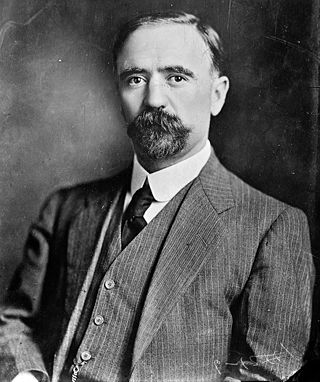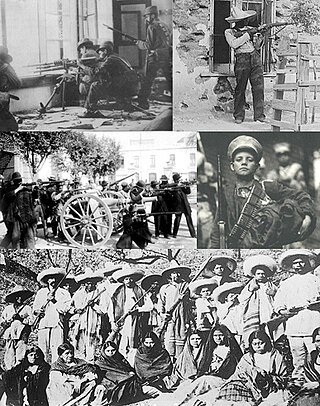
Francisco Ignacio Madero González was a Mexican businessman, revolutionary, writer and statesman, who served as the 37th president of Mexico from 1911 until he was deposed in a coup d'état in February 1913 and assassinated. He came to prominence as an advocate for democracy and as an opponent of President and de facto dictator Porfirio Díaz. After Díaz claimed to have won the fraudulent election of 1910 despite promising a return to democracy, Madero started the Mexican Revolution to oust Díaz. The Mexican revolution would continue until 1920, well after Madero and Díaz's deaths, with hundreds of thousands dead.

Francisco "Pancho" Villa was a Mexican revolutionary and prominent figure in the Mexican Revolution. He was a key figure in the revolutionary movement that forced out President Porfirio Díaz and brought Francisco I. Madero to power in 1911. When Madero was ousted by a coup led by General Victoriano Huerta in February 1913, Villa joined the anti-Huerta forces in the Constitutionalist Army led by Venustiano Carranza. After the defeat and exile of Huerta in July 1914, Villa broke with Carranza. Villa dominated the meeting of revolutionary generals that excluded Carranza and helped create a coalition government. Emiliano Zapata and Villa became formal allies in this period. Like Zapata, Villa was strongly in favor of land reform, but did not implement it when he had power. At the height of his power and popularity in late 1914 and early 1915, the U.S. considered recognizing Villa as Mexico's legitimate authority.

The Mexican Revolution was an extended sequence of armed regional conflicts in Mexico from 20 November 1910 to 1 December 1920. It has been called "the defining event of modern Mexican history" and resulted in the destruction of the Federal Army, its replacement by a revolutionary army, and the transformation of Mexican culture and government. The northern Constitutionalist faction prevailed on the battlefield and drafted the present-day Constitution of Mexico, which aimed to create a strong central government. Revolutionary generals held power from 1920 to 1940. The revolutionary conflict was primarily a civil war, but foreign powers, having important economic and strategic interests in Mexico, figured in the outcome of Mexico's power struggles; the U.S. involvement was particularly high. The conflict led to the deaths of around one million people, mostly noncombatants.

José Victoriano Huerta Márquez was a general in the Mexican Federal Army and 39th President of Mexico, who came to power by coup against the democratically elected government of Francisco I. Madero with the aid of other Mexican generals and the U.S. Ambassador to Mexico. His violent seizure of power set off a new wave of armed conflict in the Mexican Revolution.

Pascual Orozco Vázquez, Jr. was a Mexican revolutionary leader who rose up to support Francisco I. Madero in late 1910 to depose long-time president Porfirio Díaz (1876-1911). Orozco was a natural military leader whose victory over the Federal Army at Ciudad Juárez was a key factor in forcing Díaz to resign in May 1911. Following Díaz's resignation and the democratic election of Madero in November 1911, Orozco served Madero as leader of the state militia in Chihuahua, a paltry reward for his service in the Mexican Revolution. Orozco revolted against the Madero government 16 months later, issuing the Plan Orozquista in March 1912. It was a serious revolt which the Federal Army struggled to suppress. When Victoriano Huerta led a coup d'état against Madero in February 1913 during which Madero was murdered, Orozco joined the Huerta regime. Orozco's revolt against Madero somewhat tarnished his revolutionary reputation, but his subsequent support of Huerta compounded the repugnance against him.

José Venustiano Carranza de la Garza was a Mexican land owner and politician who served as President of Mexico from 1917 until his assassination in 1920, during the Mexican Revolution. He was previously Mexico's de facto head of state as Primer Jefe of the Constitutionalist faction from 1914 to 1917, and previously served as a senator and governor for Coahuila. He played the leading role in drafting the Constitution of 1917 and maintained Mexican neutrality in World War I.

The First Battle of Rellano was an engagement on 24 March 1912 during the Mexican Revolution at the Rellano railroad station, in the state of Chihuahua. It was fought between government troops loyal to Francisco I. Madero, led by General José González Salas, and rebel troops under Pascual Orozco. The battle was a victory for Orozco.

José Inés Salazar was a Mexican revolutionary general who led the Orozquistas during the Mexican Revolution and later fought with Pancho Villa. He was a native of Casas Grandes, Chihuahua.

Ojinaga is a town and seat of the municipality of Ojinaga, in the northern Mexican state of Chihuahua. As of 2015, the town had a total population of 28,040. It is a rural border town on the U.S.-Mexico border, with the city of Presidio, Texas, directly opposite, on the U.S. side of the border. Ojinaga is situated where the Río Conchos drains into the Río Grande, an area called La Junta de los Rios. Presidio and Ojinaga are connected by the Presidio-Ojinaga International Bridge and the Presidio–Ojinaga International Rail Bridge.

The Battle of Zacatecas, also known as the Toma de Zacatecas, was the bloodiest battle in the campaign to overthrow Mexican President Victoriano Huerta. On June 23, 1914, Pancho Villa's División del Norte decisively defeated the federal troops of General Luis Medina Barrón defending the town of Zacatecas. The great victory demoralized Huerta's supporters, leading to his resignation on July 15. However, the Toma de Zacatecas also marked the end of support of Villa's Division of the North from Constitutionalist leader Venustiano Carranza and US President Woodrow Wilson.

The Treaty of Ciudad Juárez was a peace treaty signed between the President of Mexico, Porfirio Díaz, and the revolutionary Francisco Madero on May 21, 1911. The treaty put an end to the fighting between forces supporting Madero and those of Díaz and thus concluded the initial phase of the Mexican Revolution.

The First Battle of Ciudad Juárez took place in April and May 1911 between federal forces loyal to President Porfirio Díaz and rebel forces of Francisco Madero, during the Mexican Revolution. Pascual Orozco and Pancho Villa commanded Madero's army, which besieged Ciudad Juárez, Chihuahua. After two days of fighting the city's garrison surrendered and Orozco and Villa took control of the town. The fall of Ciudad Juárez to Madero, combined with Emiliano Zapata's taking of Cuautla in Morelos, convinced Díaz that he could not hope to defeat the rebels. As a result, he agreed to the Treaty of Ciudad Juárez, resigned and went into exile in France, thus ending the initial stage of the Mexican Revolution.

General Jacinto Blas Treviño González was a Mexican military officer, noteworthy for his participation in the Mexican Revolution of 1910 to 1921.
The Mexican Border War, also known as the Border Campaign, refers to a series of military engagements which took place between the United States military and several Mexican factions in the Mexican–American border region of North America during the Mexican Revolution. It was the last major conflict fought on U.S. soil.
The Second Battle of Ciudad Juárez, also known as the Capture of Ciudad Juárez or “Villa’s Trojan Train” was a decisive rebel victory over the forces of Mexican president Victoriano Huerta. The federal garrison of the border city of Juárez was tricked into allowing 2,000 revolutionaries to enter the city on board a hijacked coal train. The revolutionaries crept out of the train under the cover of darkness and easily overcame the federal forces with a surprise attack.

The First Battle of Torreon, also known as the Capture of Torreon, which lasted from September 27 to October 1, 1913, was one of the battles of the Mexican Revolution, where revolutionaries led by Pancho Villa occupied a city protected by Huertist federal forces. The victory in his first large battle of the Mexican Revolution brought Villa not only a huge increase in prestige, but also considerable spoils of war in the form of urgently needed military equipment of all kinds.

The Second Battle of Torreón, which lasted from March 21 to April 2, 1914, was one of the major battles of the Mexican Revolution, where revolutionaries led by Pancho Villa occupied a city protected by Huertist federal forces.
The Third Battle of Torreón from December 21 to 23, 1916, was one of the battles of the Mexican Revolution, where troops led by Pancho Villa occupied the city, protected by Carrancist forces.

Benjamín Argumedo Hernández (1874–1916) was a Mexican Brigadier General. He participated in the anti-reelectionist side at the beginning of the Mexican Revolution, but in 1912 he joined the opposition against Francisco I. Madero and supported the coup d'état of Victoriano Huerta. Also known as the Lion of the Lagoon. He is considered the most tenacious adversary of Francisco Villa in the bloody battles that were carried out for the lands of Durango and Coahuila, because it was said of him that he was never afraid. During the first captured of Torreon that occurred between May 13 and 15 of 1911, Argumedo gave the order to "kill all Chinese", after which they were massacred 303 residing Chinese and Japanese in the city, who were falsely accused of having shot against the Maderista hosts that Argumedo commanded together with Sixto Ugalde, Jesús Agustín Castro and Epitacio Rea, among others.

Raúl Miguel Hidalgo Madero González was a prominent Mexican revolutionary military and politician, brother of the hero of the Mexican Revolution. He was the brother of Francisco I. Madero and businessman and politician Gustavo A. Madero.

















